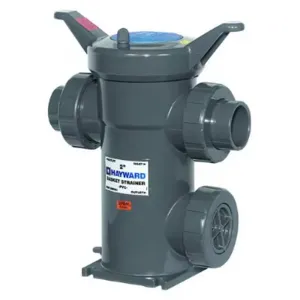Hayward SB1075ST132 basket strainer filters out solid contaminants from flowing liquids, ensuring the purity and integrity of the final product or process. By trapping debris, particles and unwanted materials, the basket strainer prevents damage to sensitive equipment, such as pumps, valves and meters. It is ideal for chemical processing, water treatment, oil and gas and food processing tasks.
Features:
- It has a maximum pressure rating of 150 psi.
- This basket strainer has a screen perforation size of 0.0312 inches for filtering out small particles and debris.
- It comes with a hand-removable cover to facilitate easy access for maintenance and cleaning without special tools.
- This basket strainer offers a drain plug of 3/4 inches, enabling efficient removal of trapped debris and fluid drainage.
- It features PVC housing, providing resistance to UV light, chemicals and corrosion in diverse industrial environments.
- It offers a screen area of 37.03 square inches, optimising filtration efficiency and flow capacity for various applications.
- This basket strainer is compliant with NSF/ANSI standards 372 and 61, ensuring the safety and quality of water and process liquids in regulated industries.
Frequently Asked Questions:
Q. How often does this Hayward SB1075ST132 basket strainer require maintenance?
A. Maintenance frequency depends on the application and contaminant level in the fluid. Generally, you should periodically inspect and clean the screen to ensure optimal filtration efficiency and prolong the lifespan of the strainer. With the hand-removable cover and PVC construction, this strainer offers easy access for maintenance and excellent resistance to chemicals and corrosion, making it a reliable choice for diverse industrial applications.
Q. How does the screen perforation size affect the filtration efficiency of this Hayward SB1075ST132 basket strainer?
A. The screen perforation size determines the particle size debris that the strainer can capture. A smaller perforation size allows for finer filtration but may require more frequent maintenance, while a larger perforation size offers higher flow rates but may allow larger particles to pass through.




